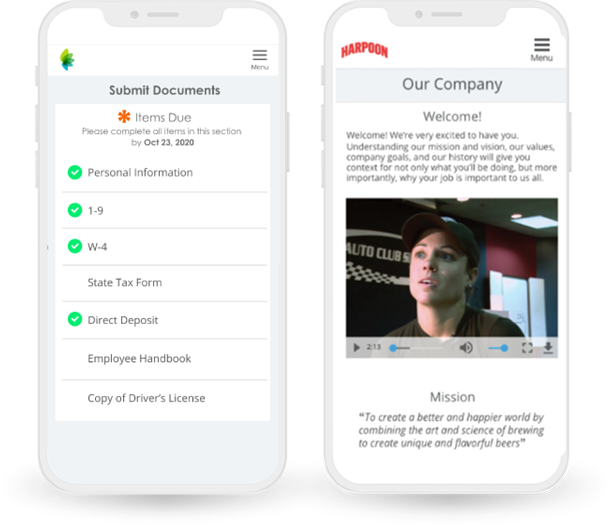As HR professionals and hiring managers, you understand what goes into creating a successful onboarding program. Onboarding is so much more than signing forms and setting up laptops. It’s about welcoming new members of the team, preparing them for their new role, and setting them up for a long tenure at your company.
Today’s job market demands that companies meet the needs of their employees, prepare them for their roles, and provide support to help them be successful. With about 52% of the workforce expected to search for a new job in the first six months of 2022, it’s essential that your onboarding program contributes to retaining every new hire.
In today’s post, we’re taking a look at some essential elements of a successful onboarding program. You’ll also find exclusive downloadable content, including an onboarding checklist template you can try with your new hires.
52% of the #workforce is expected to search for a new job in the first six months of 2022. Hang onto your new hires with an effective #onboarding program. Learn more in @ClearCompany’s latest post:Onboarding Doesn’t Happen Overnight
The best employee onboarding programs last much longer than one day or even one week. You wouldn’t expect new employees to hit the ground running their first day on the job — it takes time to ramp up responsibilities, settle into daily routines, and get a feel for company culture.
Many standard onboarding programs are 90 days, though some are even longer than that, depending on the role. According to Gallup, around one year into employment is when employees are performing at their best. Gallup also says that a 12-month onboarding process is an excellent way to foster engagement when employees are most susceptible to leaving.
Be sure not to rush through onboarding processes, and take the time to connect new employees to the company’s mission, vision, and values to encourage engagement from the start. Only 29% of new hires say they feel like they are prepared and supported when their onboarding program is complete. You don’t want your employees to be among them — prioritize their success with a great onboarding plan.
Did You Know: Only 29% of new hires say they feel like they are prepared and supported when their onboarding program is complete.
Create an Onboarding Checklist for Every Role
You can help new employees feel more confident with an employee onboarding checklist. The checklist details everything they’re expected to complete during the onboarding process. This doesn’t just reduce confusion for your new employees — it simplifies the process for everyone. A checklist ensures that HR teams don’t skip any steps in the process, get the appropriate documents from new hires, and share the same information about company culture.
Create multiple checklists to ensure that employees cover all of the essentials for onboarding. Your checklists will likely vary depending on the employee’s role, seniority level, and other factors, but you can follow the same process for creating checklists for any role. Divide your checklists up by day, week, and month so employees aren’t overwhelmed and are well-prepared for their new roles.
- The day-one checklist can include a quick meeting with HR, an introduction to the team, and a simple assignment so employees can jump in headfirst.
- The week-one checklist might include an end-of-week check-in, ensuring the employee is set up with the right software and equipment, and introducing the new hire to processes they’ll be using.
- 30-, 60-, and 90-day checklists may include meetings with a mentor, a new-hire performance review, and completing a project.
Take Advantage of Onboarding Software
Onboarding software can help make onboarding a more seamless experience for employees and HR teams alike. Onboarding software makes the logistics of onboarding a lot easier, allowing new employees the chance to begin forming relationships with their colleagues and taking over their role responsibilities.
If you have a remote workforce, a software solution is essential for onboarding remote employees. The tools effective onboarding software equips your HR team with include:
- An employee self-service portal so new hires can access the documents and resources they need at any time
- Device and equipment management so HR and IT teams can track employee equipment effortlessly
- Electronic completion and storage of all forms and documents, including background checks, 1-9s, and tax documents
- Intelligent forms with autofill for faster form completion
- Bulk onboarding so HR can quickly onboard large groups of new hires
- Automated notifications to keep the onboarding process on track
- Analytics to assist with evaluating the quality of new hires
Get Employees’ Insights
The employees who go through your onboarding program have a unique view of how it really works. Harness that knowledge by conducting surveys of new hires asking them to rate their onboarding experience. You can ask these questions at various points in the onboarding program or when employees complete the program.
Nearly 90% of employees decide if they’ll stay at the new company in the first six months.
Here are some sample questions to ask new employees:
- Did you feel prepared to start your first day (equipment delivered and set up, email account activated, meeting set with hiring manager)?
- Did you feel your onboarding program was too long, too short, or just right?
- How was your experience with the onboarding software?
The key to an excellent employee experience is its start: a great onboarding experience. It’s essential because almost 90% of employees decide if they’ll stay at the new company in the first six months. That’s especially important during a time when hiring has become difficult across industries and occupations. Onboard new employees with the intention to show them you care about their success in their new role.
You can create the most effective onboarding plan possible to engage and retain your employees with the help of our employee onboarding checklist. Jumpstart a great onboarding plan that keeps every employee on board long-term — download the checklist now.


